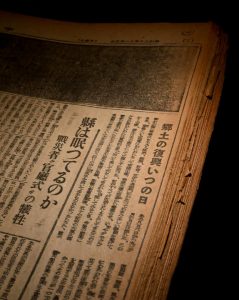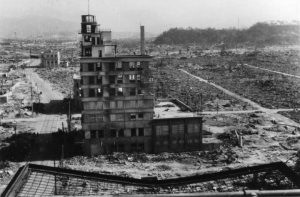Documenting Hiroshima of 1945: November 5, Chugoku Shimbun resumes printing of newspaper on its own
Nov. 5, 2024
by Maho Yamamoto, Staff Writer
On November 5, 1945, the Chugoku Shimbun resumed printing of the newspaper on its own for the first time in about one month and a half. The company’s printing facilities at its head office in the area of Kaminagarekawa-cho (in Hiroshima City’s present-day Naka Ward) had been incinerated by the dropping of the atomic bomb on the city. The company began using a rotary printing press it had moved before the bombing to the village of Nukushina (in the city’s present-day Higashi Ward) in Hiroshima Prefecture and restarted printing its newspaper starting with the daily edition dated September 3. Nevertheless, the process had to be halted again after the printing of the September 18 edition due to damage from flooding caused by the Makurazaki Typhoon. The newspaper’s November 5 edition was printed at the head office, which stood amid the ruins of the city.
After being discharged from the military, Akira Yamamoto, 26 at the time and head of the company’s general affairs department, was engaged in an effort to recover printing operations at the head office under the leadership of his father Jitsuichi, who was president of the Chugoku Shimbun at the time. Akira later served as president and died in 1998 at the age of 78. In a memoir he wrote while alive, Akira recalled the printing work starting “the night of November 4.”
According to Shinrai (in English, ‘Trust’), a book published in 2012 that was a collection of feature articles carried in the Chugoku Shimbun based on his memoir, “Around the time the sky grew brighter before daybreak, we finally began to hear the sounds of the pleasant rhythms [of the rotary printing press]. Listening to that roar while standing still near the machine, I shed tears as I remembered the faces of those who had perished.” (The following statements are also based on the same publication.)
A total of 114 Chugoku Shimbun employees, or around one-third of the total number, had been killed in the atomic bombing. The decision was made to resume printing at the head office after the flooding, but the company building had been “left with several centimeters of accumulated ashes on the floor” after its interior was incinerated at its location around 900 meters from the hypocenter.
Considering it urgently necessary to look into the issue of residual radiation at the site, Jitsuichi asked for the opinion of the specialist Masao Tsuzuki, a professor at Tokyo Imperial University (present-day University of Tokyo), and made a request to Hiroshima University of Arts and Science (present-day Hiroshima University) to conduct an investigation, the results of which considered the site to be fine. The rotary printing press, touted as a “lifeline for all employees,” was disassembled and transported from Nukushina to the head office by a horse-led cart. A team of engineers from Toyo Kogyo (present-day Mazda Motor Corporation) stayed overnight at the office to reassemble the parts.
The Chugoku Shimbun published on November 5, a date just prior to three months after the atomic bombing, carried the headline, “When will restoration of our hometown be achieved?” Information about the circumstances in the city regarding housing, lighting, and public transportation was covered in the article, which argued, “What citizens are desperately seeking is not an intricate and grand vision of recovery, but simply an idea about the provision of housing and clothing to ward off the cold and a food supply to stave off hunger.”
To serve as protection against the wind and rain, the office building’s windows, which had been blown out by the bomb’s blast, were covered with wood panels. The space was also used as a tentative residence for employees who had lost their homes.
(Originally published on November 5, 2024)
On November 5, 1945, the Chugoku Shimbun resumed printing of the newspaper on its own for the first time in about one month and a half. The company’s printing facilities at its head office in the area of Kaminagarekawa-cho (in Hiroshima City’s present-day Naka Ward) had been incinerated by the dropping of the atomic bomb on the city. The company began using a rotary printing press it had moved before the bombing to the village of Nukushina (in the city’s present-day Higashi Ward) in Hiroshima Prefecture and restarted printing its newspaper starting with the daily edition dated September 3. Nevertheless, the process had to be halted again after the printing of the September 18 edition due to damage from flooding caused by the Makurazaki Typhoon. The newspaper’s November 5 edition was printed at the head office, which stood amid the ruins of the city.
After being discharged from the military, Akira Yamamoto, 26 at the time and head of the company’s general affairs department, was engaged in an effort to recover printing operations at the head office under the leadership of his father Jitsuichi, who was president of the Chugoku Shimbun at the time. Akira later served as president and died in 1998 at the age of 78. In a memoir he wrote while alive, Akira recalled the printing work starting “the night of November 4.”
According to Shinrai (in English, ‘Trust’), a book published in 2012 that was a collection of feature articles carried in the Chugoku Shimbun based on his memoir, “Around the time the sky grew brighter before daybreak, we finally began to hear the sounds of the pleasant rhythms [of the rotary printing press]. Listening to that roar while standing still near the machine, I shed tears as I remembered the faces of those who had perished.” (The following statements are also based on the same publication.)
A total of 114 Chugoku Shimbun employees, or around one-third of the total number, had been killed in the atomic bombing. The decision was made to resume printing at the head office after the flooding, but the company building had been “left with several centimeters of accumulated ashes on the floor” after its interior was incinerated at its location around 900 meters from the hypocenter.
Considering it urgently necessary to look into the issue of residual radiation at the site, Jitsuichi asked for the opinion of the specialist Masao Tsuzuki, a professor at Tokyo Imperial University (present-day University of Tokyo), and made a request to Hiroshima University of Arts and Science (present-day Hiroshima University) to conduct an investigation, the results of which considered the site to be fine. The rotary printing press, touted as a “lifeline for all employees,” was disassembled and transported from Nukushina to the head office by a horse-led cart. A team of engineers from Toyo Kogyo (present-day Mazda Motor Corporation) stayed overnight at the office to reassemble the parts.
The Chugoku Shimbun published on November 5, a date just prior to three months after the atomic bombing, carried the headline, “When will restoration of our hometown be achieved?” Information about the circumstances in the city regarding housing, lighting, and public transportation was covered in the article, which argued, “What citizens are desperately seeking is not an intricate and grand vision of recovery, but simply an idea about the provision of housing and clothing to ward off the cold and a food supply to stave off hunger.”
To serve as protection against the wind and rain, the office building’s windows, which had been blown out by the bomb’s blast, were covered with wood panels. The space was also used as a tentative residence for employees who had lost their homes.
(Originally published on November 5, 2024)









